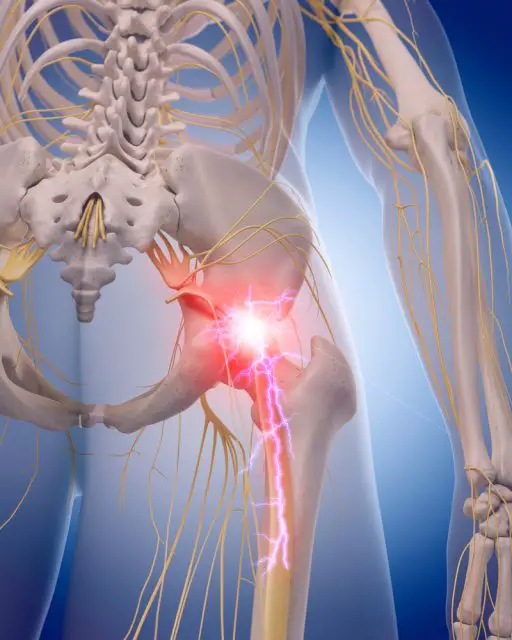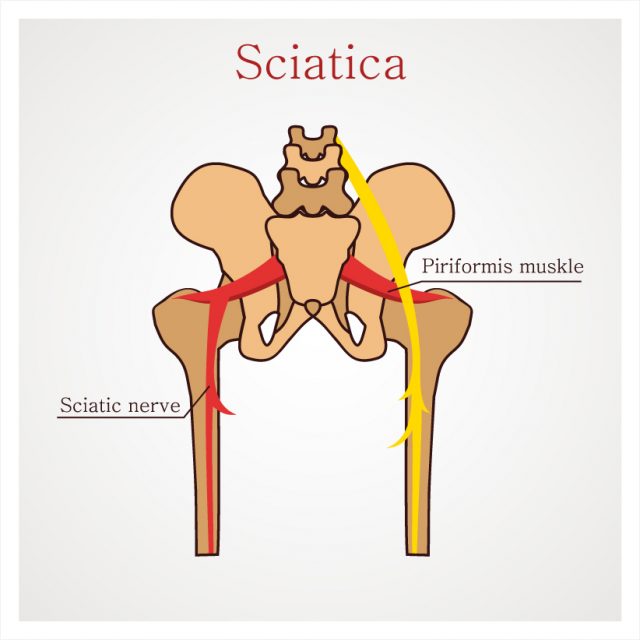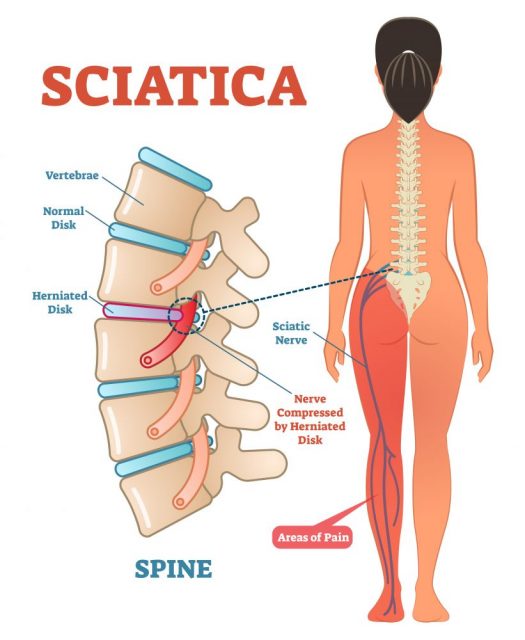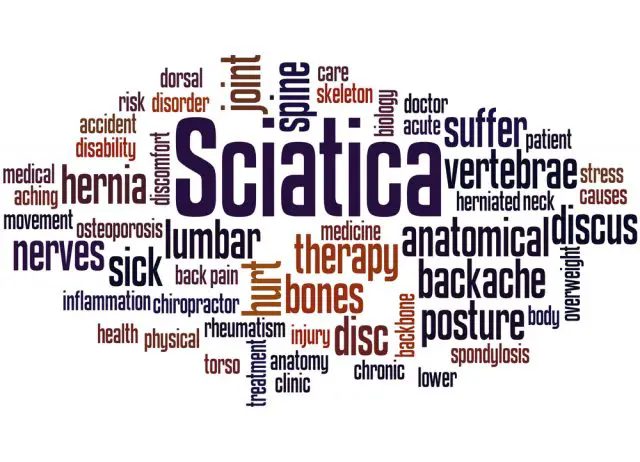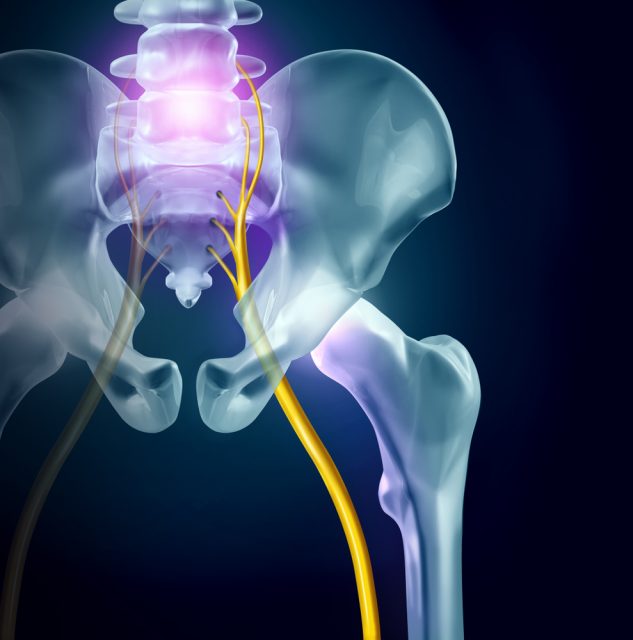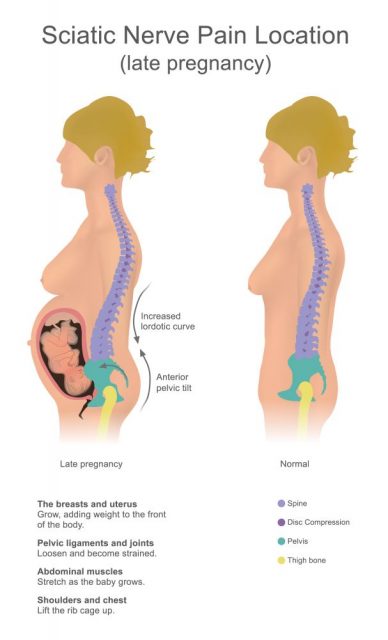Sciatica: Symptoms, Causes, Treatment and Exercises
An Introduction To Sciatic Nerve Pain
The sciatic nerve is a system of several different nerves all operating from a single base. These nerves connect in the lower back, then stretch down the back of both legs. The term “sciatica” actually refers to the set of symptoms. It is not a medical diagnosis. Anyone with pain in the back of their legs can refer to this as sciatica. Sciatica refers to numbness, tingling, weakness, and general pain ranging from the lower back right down to the toe.
Sciatic nerve pain specifically refers to pain directly related to the nerve itself. This is often from damage due to compression or a pinched nerve. There are many medical issues or lifestyle choices that result in back pain. However, sciatic nerve pain often only affects one side of the body, not both. This, paired with any symptoms, narrows down the list of back pains. If you’re only experiencing discomfort and immobility on one side, it’s likely related to the sciatic nerve.
While sciatic nerve pain is often caused by something menial, like overexertion, there are also underlying medical issues that could be the cause. This is why it’s important to avoid self-diagnosing and actually see a doctor.
Sciatic Nerve Pain Location
Any back injury, leg or foot injury can cause damage to the sciatic nerve as they are all connected. This also means the sciatic nerve can cause pain in throughout the lower half of the body. Depending on the location of the sciatic nerve damage, the pain may even affect the foot and toes. Generally, the pain is central to the lower back, rear, and back of leg. Sciatic nerve pain in feet can be hard to handle, since it reduces mobility by quite a bit. This type of pain is often characterized by a shooting pain from the heel of the foot into the lower back. This is a good indication there is something wrong with the sciatic nerve.
When you’re experiencing any kind of back pain, it’s helpful to note the centralized location. The location of the pain is a good indication to the problem at hand. Your doctor is going to want to know the location of the pain, as well as other symptoms you might be experiencing. Before your appointment, make sure you’re ready to answer questions about:
- The location of the pain
- The type of pain you’re experiencing
- How frequent the pain/numbness is
- How mobile you are
- When the pain starts
- When the pain feels better
- If any trauma has happened recently
- Whether or not there are incontinence issues
These questions will help your doctor to determine the severity of the case.
Sciatic Nerve Pain Symptoms
Below is a list of the most common symptoms noted in relation to sciatic nerve pain:
- Pain in the lower back
- Pain in the rear, often worse when sitting
- Pain in the back of the leg, also worse when sitting
- Pain radiating around the hip bone(s)
- Burning sensation up and down the leg
- Tingling sensation up and down the leg
- Weakness in one leg or foot
- Numbness in one leg or foot
- Difficulty moving the leg or foot
- Consistent pain to one side of the rear
- Shooting pain throughout the leg
- Difficulty standing up
Emergency symptoms include:
- Lower extremity weakness that completely restricts movement
- Numbness central to the upper thigh area
- Loss of bladder control
- Loss of bowel control
As you can see, many of the symptoms of sciatic nerve damage involve limited movement or pain directly in the back, leg, and foot. Anything below the sciatic nerve tends to have difficulties functioning normally until the sciatic nerve pain is resolved. The pain is often described as “burning, searing, sharp, or electric-like pain”. It’s uncommon that sciatic nerve pain would be dull or throbbing.
There are a few other medical conditions that have symptoms similar to sciatic nerve pain. One of these conditions is pressure from the piriformis muscle, which causes the sciatic nerve to be irritated. Another of these conditions is sacroiliac joint dysfunction. As you can guess, this condition can be considered a little more serious and needs to be ruled out by a doctor. Pregnancy also causes lower back pain, commonly thought to be related to the sciatic nerve.
The Most Common Sciatic Nerve Pain Causes
The most common cause of the pain in the sciatic nerve is simply irritation. This could be from excessive movement leading to a pinched nerve or it could be a blunt trauma to the lower half of your body. There are also lifestyle choices that increase the risk of sciatic nerve pain. Here are a few:
- Inactivity
- Smoking
- Being overweight
- Being above-average in height
- Over the age of 60
- Sleeping on a soft mattress
- Sleeping on a hard mattress
- Wearing high heels
- Performing a job or activity that requires excessive/heavy lifting
- Performing a job or activity that requires repetitive twisting
- Performing a job or activity that requires excessive driving (due to vibrations)
- Excessive strain on their lower back
- Excessive stress
- Excessive work-outs
- Not warming up before a work-out
- Pushing your body beyond it’s capability
Many people have noticed sciatic nerve pain after working out. This is because a typical work-out will put a non-typical amount of pressure on your lower back. Many times, this isn’t actually a medical concern, simply a pinched nerve that needs time to heal. This is one of the reasons it’s so important to stretch before you perform any kind of work-out. Whether you’re jogging or taking to the weights, you need to make sure your body is warmed up. Similarly, you also need to make sure you’re not overdoing yourself. It can be tempting to push yourself, but it’s too easy to go beyond your capability. Make sure to take it slow and introduce new work-outs gradually.
Often, a pinched nerve will resolve itself with rest and relaxation. This gives your body the chance to heal itself and allow you complete movement once again. This can be tricky if your job is causing the pain (such as lifting, driving, twisting, etc). However, most employers are understanding of the need to rest. Make sure you’re presenting a doctor’s note that specifies how much time you need to take off. Don’t get fancy with your time off; use it to heal.
Unfortunately, rest isn’t always the case and it should never be assumed that the pain will work itself out. There are more serious health issues that can lead to sciatic nerve pain and these issues can be severe. By ignoring any type of lower back pain, you’re at risk for worsening symptoms and increasing the chances of developing a more serious condition. It’s always best to see a doctor regarding sciatic nerve pain and it’s good to know what you might be dealing with.
- An accident/injury
- Lumbar Spinal Stenosis (narrowing of spinal canal)
- Degenerative disc disease
- Spondylolisthesis (vertebra slips over another)
- Muscle spasms
- Pregnancy
Extreme cases note that a tumor may be the reason behind sciatic nerve pain. This type of cause is considered to be extremely rare and unlikely to be considered during initial diagnosis.
Pregnancy is commonly believed to cause sciatic nerve pain. After all, lower back pain in extremely common in pregnant women. There’s even a good chance all of the symptoms are present. However, pregnancy does not increase the likelihood of getting sciatic nerve pain. In fact, most sciatic nerve pain during pregnancy is more often pelvic girdle pain. PGP mimics the same symptoms as sciatic nerve pain, which can lead to an improper diagnosis.
Living With Sciatic Nerve Pain and Treatment Methods
Diagnosing sciatic nerve pain can be difficult. Largely, your doctor will go by your description of the pain, including location and severity. You’ll be asked about your medical history, as well as general questions about your lifestyle. This is to determine if there are any risk factors in your life or your medical history that would indicate increased chances for sciatic nerve pain. Typically, there will also be a physical examine. This is generally just to test the range of motion within your lower half. Patients that appear to have sciatic nerve pain will be put through non-surgical treatment.
Diagnostic imaging may be used when a patient doesn’t respond to the non-surgical treatment after a period of 6-8 weeks. Alternatively, if the symptoms worsen in any way, surgery may be suggested. Surgery may also be considered for any patient suffering issues with incontinence or patients that are completely unable to move.
Generally, sciatic nerve pain isn’t hard to live with. For many, it’s simply irritating and inconvenient. For others, it causes completely immobility. It can be severely crippling, especially when it’s left untreated. Several treatment methods are available to those who suffer from sciatic nerve pain.
This list is not inclusive, but it’s a general idea of the help that is available.
- Rest
- Heating pad
- Cold compress
- Over-the-counter medication for pain relief
- Prescription medication for pain relief
- Physiotherapy
- Massage (to work out strain)
- Chiropractic/manual manipulation
- Acupuncture
- Stress-management
- Cognitive behavior therapy
- Homeopathic remedies
- Colocynthis; ideal when pain is focused on the left side
- Magnesia phosphorica; ideal when pain is focused on the right side
- Exercise
- Surgery
Surgery, although not recommended, offers immediate relief of sciatic nerve pain. Alternative methods of rehabilitation take longer to see relief. However, Spine-Health.com suggests that after a 2 year period, the results are the same. Therefore, surgery is considered as a last resort.
Sciatic Nerve Pain Exercises
There are many exercises that aim to help you regain mobility. But, before you jump into any exercises, please take caution. There are certain poses and movements that may not be realistic for you. Depending on the cause of your sciatic nerve pain, you may need tailored exercises from a physiotherapist. Below are a few beginners poses, generally safe for everyone. They don’t require much flexibility, but aim to target specific parts of the body that contribute to the pain you’re feeling.
Remember to warm up before you get started and take a break between exercises.
- Reclining pigeon pose
- Lay on the ground, flat on your back
- Bring one leg up to a 90/180 degree angle
- Place both hands on the back of the thigh
- Wrap your fingers together
- Lift your other leg, pressing your thigh to your foot
- Hold this position
- Slowly bring both legs back to a starting position
- Repeat with the alternate leg
- Sitting pigeon pose
- Sitting on the floor, stretch both legs out straight
- Bend one leg, placing the ankle on top of the other knee
- Lean forward
- Hold this position for 15-30 seconds
- Resume starting position
- Repeat these steps using the other leg
Alternatively, you can participate in many low-impact exercise options, such as:
- Exercise walking
- Elliptical trainer
- Step machine
- Stationary bicycling
- Swimming
- Water aerobics
- Yoga
You don’t need to get fancy any buy any of these machines. For many, it’s as simple as a gym membership. Maybe you never thought you’d need one. Maybe you have one and haven’t used it. Either way, there’s no time like the present to get out there and start working to help your body function properly. This also includes healthy eating, if you’re not doing that already.
If your lifestyle choices result in sciatic nerve pain, it’s time to eliminate anything you can. For instance, high heels may help you to stand out, but is it worth the back pain at the end of the day? Evaluate what is more important in your life and start making the changes that are necessary.
Conclusion
The human body is an intricate design with many nerves that can be easily damaged. If any of these damages are ignored, the issues get worse and worse. It is important that everyone goes in for an annual routine check-up to ensure nothing is slipping out of place. This is particularly true for those with an overly active lifestyle and those who are getting on in age. If there is any pain associated with a lack of movement, you need to see a doctor.
Your sciatic nerve pain may need nothing more than a week of rest. If that doesn’t seem to help, it’s time to make an appointment with someone who might know a better method of rehabilitation. You really need to rule out alternative medical conditions in order to live a happy and healthy life.

